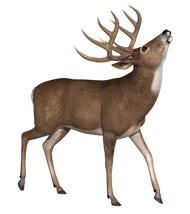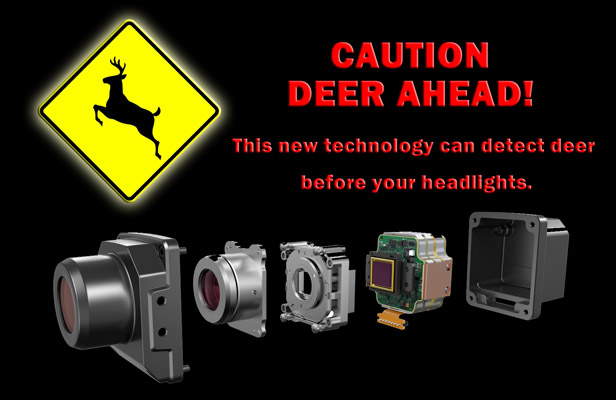How Deer Accidents Happen and How to Avoid Them
Posted by Speedir thermal vision on 30th Dec 2019
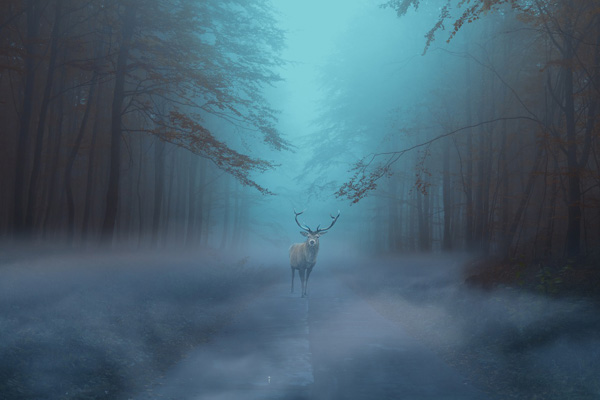
Updated March 2023
Whether you drive frequently in and around wooded areas or you're a city dweller that only ventures out once in a blue moon, the prospect of hitting a deer with your car is a scary thought.
Unfortunately, deer-vehicle collisions are common, to the tune of 1.6 million accidents per year according to the Insurance Information Institute. But it's not just an inconvenience. Deer accidents lead to hundreds of deaths, tens of thousands of injuries and billions of dollars in vehicle damage each year. And as you venture out each and every day, you never know when you'll be affected by a deer-car accident. Statistics tells us that, sure, the likelihood of hitting a deer is actually pretty low. But at night and during the fall mating season as days become shorter and deer venture out earlier, accidents spike, which can do more than just ruin your day.
Many of those accidents lead to injuries and most lead to costly vehicle repairs. Deer have overpopulated the country and that means there are more of them than ever. Deer move around a lot and when their habitats are disturbed or when roads are constructed in them, they tend to ignore danger and follow their instinct to travel as needed for food, safety, and mates.
Making matters worse, the Highway Data Loss Institute reports that while deer accidents have held steady over the years, costs to motorists have risen dramatically, primarily due to the increasing cost of delicate car components that must be wholly replaced when they're damaged -- and crumple zones that favor the destruction of car parts rather than sending the extraordinary car-crash forces into the cabin to the occupants inside. Make no mistake, it's great for the health of drivers and their passengers, but it also means that even the most innocuous fender-bender can lead to associated costs well into the thousands, and sometimes even into the tens of thousands or render your vehicle inoperable or, worse yet, totaled.
But we all know that the risk of an auto accident is a given in today's world. It's all about how you manage that risk, and some preparation, quick thinking and the prevalence of basic and advanced technology can help drivers wholly avoid or minimize their next encounter with a deer.
Drivers are always looking for new ways to protect themselves from wildlife accidents and deer vehicle collisions. Using bright headlights and deer whistles that attach to the front of a vehicle and make noise are a few options, but those don’t work well and usually do very little to prevent an accident. You can’t count on fear to prevent deer from running in front of your car. It’s up to you to be alert and know where they are so you can stop your vehicle to avoid the danger of hitting deer while driving.
Why are deer attracted to roads? Why do deer get hit by cars?
Many deer that live near roads and highways that have a lot of traffic become accustomed to the sounds of moving vehicles. Deer often graze in fields and pastures near highways or woodland areas near country roads. Deer also travel across these roads to find mates or food. They either learn that they are dangerous and choose to avoid the roadways or they stop fearing them and eventually wander out onto the roads where they can cause accidents.
Deer that are not accustomed to the sounds of cars may be spooked by the noise. Deer run without thinking when scared and can unknowingly run in the direction of the sound instead of away from it. Once they get to a road, they become even more scared and often panic, which can cause them to freeze or even run towards a vehicle.
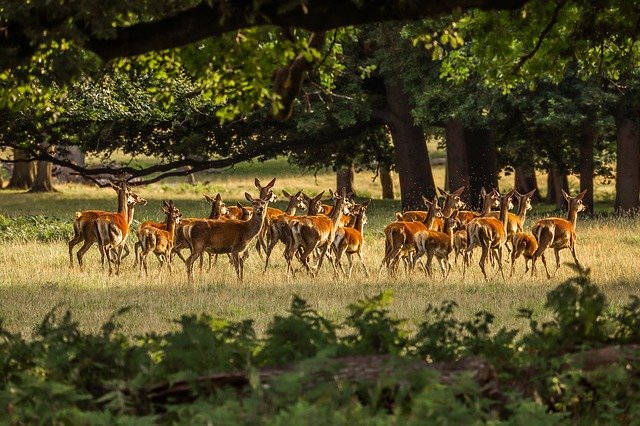
Where Do Deer Live and Why Do They Move?
Deer move around to find food, but they also have more secure areas where they like to bed down or sleep. They prefer to stay deeper in the forest where they feel safe in the summer and early fall when they can hide behind leaves and thick plants. When the leaves start to die and fall from trees, they feel more exposed to danger and are move likely to move around. They also look for fresh food. During the rutting season, both males and females are on the move. They may behave oddly, and many male deer are so focused on finding a mate that they pay very little attention to anything around them.
Seasonal changes like this can bring deer near busy roadways. It’s not uncommon to see deer feeding on the side of a highway or road, especially in the early more hours or at night. You may also see deer traveling in herds, depending on the time of year. More deer moving and large groups of deer traveling together can lead to more wildlife collision accidents.
Why Do Deer Jump in Front of Cars? Also, why do deer like running in front of cars?
Deer don’t jump in front of cars deliberately. Most are spooked by the sounds of the traffic and become confused as to which way to run. They may dart out in front of cars, stand still in the road, and even run towards moving vehicles when they mean to run away from them. Deer also jump in front of cars while trying to cross roadways. They may be trying to cross to find food, to get back to the spot where they bed down, or to find a mate.
Headlights confuse deer, especially at night. When they look into the lights, they are temporarily blinded which can cause them to stand without moving or run blindly in a random direction. When new roads are built in existing deer habitats, the deer may continue to travel their usual routes and distances without understanding that there is any danger. The biggest reason deer jump in front of cars is because they are scared.
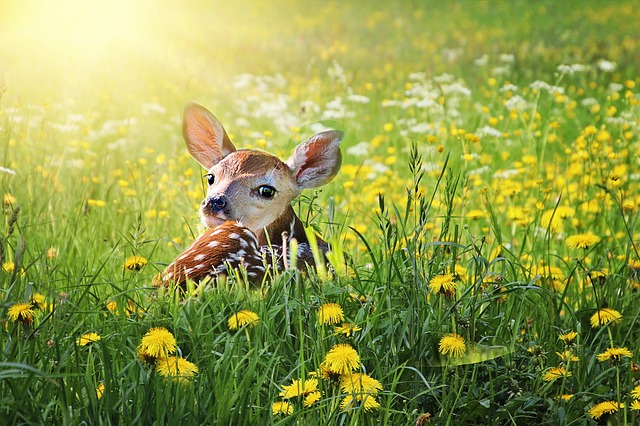
How Can an Early Warning System Will Help Prevent Accidents?
Since using whistles and lights only make deer more likely to be startled when the car approaches, it best to use an early warning system that alerts the driver that a deer is on the road or nearby, instead of alerting the deer that the car is coming. An early warning system can let you know there is wildlife or a pedestrian in the road so you can stop your car or pull over to avoid deer while driving.
How Our Thermal Camera Can Help Avoid Wildlife Collision
Our thermal driving camera is designed to help prevent deer accidents. The Speedir thermal camera attaches to your vehicle and scans the road in front of you while you are driving. Thanks to Thermal night vision for driving, it could recognize pedestrians or wildlife before your headlights shine on them. The camera can even see through fog, smoke, dust, and poor weather conditions.
Not only does our early warning system tell you if there is wildlife nearby, but the built-in artificial intelligence can also identify the object and even give a visible and audible warning up to 400 feet away. There is even a coded distance warning that tells you if the wildlife on the road is close, medium, or far away. It works on any type of vehicle and connects to any automotive screen to display a video feed.
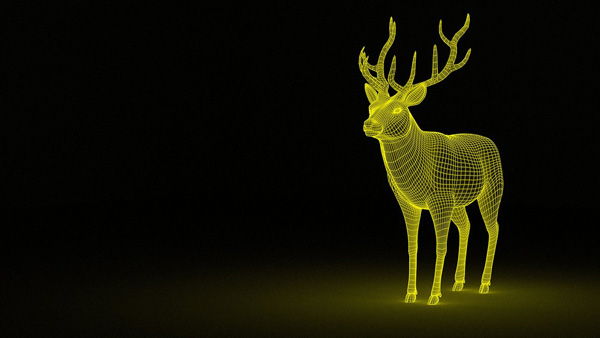
By the time your headlights spot a deer, it may already be in the road and or moving towards your vehicle too fast for you to stop. No amount of lights or deer whistles can prevent you from hitting a deer or keep a scared deer from running in front of cars. Our Night Owl Plus Vehicle Thermal Night Vision Camera with AI can help you see a deer before it’s on the road or as it’s approaching the road. Since it can detect heat and motion from a great distance, you will have plenty of time to stop to avoid a deer collision. If you are hoping to avoid hitting a deer, our thermal driving camera may be right for you.
How to Avoid Hitting a Deer
Especially if you live in one of the more densely deer populated sections of America, the specter of an impending deer collision can cause anxiety on the road—and that’s one of the better things it can cause.
Based on the results of a study performed by the National Highway Traffic Safety administration, over 1 million deer accidents involving cars happen yearly in United States. At least 200 of those are fatal for the deer, the persons in the car, or both. It’s in everyone’s best interest, then, to establish best practices so you don't end up saying, "I hit a deer" after a deer vehicle collision.
However, the steps to prevent one of these tragedies may not be as foolproof as you think. Read on for a comprehensive list of strategies—and the one that we recommend the most! Note that it’s probably a good idea to implement all of these ideas into your driving routine.
Ways to Stop Wildlife Accidents From Happening
Drive Defensively During Peak Deer Hours. Wherever you’re driving, whether it be suburbia or a rural mountain road, you definitely need to look up which hours are likely to be the ones that deer are more active. These can vary from place to place, but a typical set of peak deer hours would be the hours between sunset and midnight as well as the hours just after sunrise. If you're driving between the hours of 6pm and 9pm, especially in wooded areas or close to where deer live, mate or travel, please slow down. At higher speeds, our reaction times are limited, and reduced visibility at dusk further exacerbates the likelihood of hitting a deer. During those times, be sure to be on the lookout for wildlife trying to cross the road — especially just around turns, and especially if the forest comes straight up to the edge of the road.
Be Extra Careful When Driving Through a Protected Deer Crossing Zone. If a specific walkway has been noted where deer tend to cross a street, know that that sign is there for a reason! These signs have been placed in places where deer were noted to be in large populations and have needs to get from one side of the road to the other — so the likelihood that you’ll see a deer there is relatively high. Posted signs usually indicate prior accidents, close calls and sightings, so you should be extra vigilant when traveling on these roads, particularly at dawn or dusk or in the fall when mating season picks up. Be extra cognizant of your driving habits while in these areas! It’s also a good idea to look up whether your destination or the places through which you’ll be driving have naturally high deer populations; that’ll help guide you as you take your accident-free journey.
Be Aware that Deer Tend to Run in Packs. Humans are social creatures; so, as it turns out, are deer. This means that if you see one deer running by the side of the road, there’s likely one or more around that you don’t see! As deer are very quick, nimble creatures, even if the deer is running on the road beside you, they can easily dart out into the road in front of you with precisely zero notice. If there’s a deer anywhere on the road near you, you should likely stop or slow—they may have friends nearby who you’re not even tracking! Always err on the side of caution when it comes to driving near deer. If you see an animal on the side of the road, even if it's not a deer, be alert. Where there's one, there's likely more, and deer and other animals mostly travel and congregate in groups.
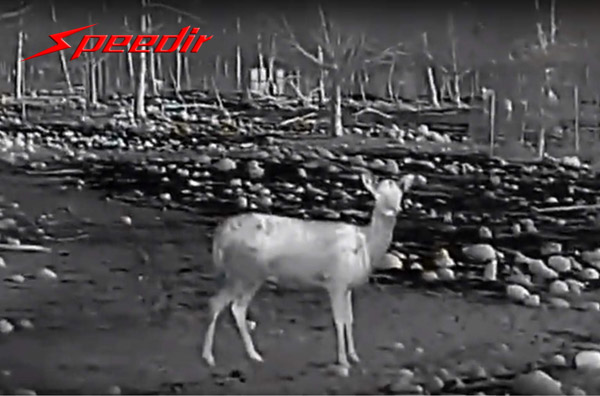
Protect Yourself and Nearby Deer with Your High Beams: You may already know this, but it’s a good practice to double down on when it comes to protecting deer, your car, and your life. If you’re driving around a windy road late at night, and you’re the only car on the road — switch on your high beams. While it’s not a good idea to use these beams in traffic, when you’re alone they can really help illuminate the woods and road around you (including making deer’s shiny eyes really pop, which can give you a head’s up you wouldn’t have had otherwise.) Make sure to switch off your beams if there’s any oncoming traffic, though!
Use Your Horn as a Helpful Warning Siren. If you do see a deer, don’t just wait it out. Deer aren’t the smartest creatures in the animal kingdom, but they are easy to frighten. When deer are nearby, as long as there isn’t nearby traffic for you to startle, go ahead and slow way down, then look at the deer and give them a long honk with your horn. They should start at this, and run away. If that doesn’t work, start giving them repeated beeps with your horn. Deer hate repetitive loud noises, and this should at the very least scare them away from coming any closer to you and your vehicle.
Stay (and Brake, Hard) in Your Lane. Most fatalities related to accidents with deer don’t happen on collision with the deer itself — they come when drivers swerve out of their lane to avoid hitting a deer and crash head-on with oncoming traffic or nearby wildlife. Swerving is an instinctive response. Fight it! If you see a deer entering the roadway ahead of you, brake immediately, and don't swerve. According to experts, most injuries, fatalities and damage occur not from a deer-vehicle collision, but from drastic swerving and attempts to avoid a deer. In fact, swerving can send you off the road or into oncoming traffic, and even if you move out of the way, a scared and confused deer might dart in the same direction as your headlights. Deer collision prevention is more about breaking than swerving. When you see a deer which is in or near your path, brake as firmly as you safely can—but stay in your lane. Then, you can move on to other evasive or protective maneuvers, as detailed above. However, if you instinctively swerve, then you may have just created another problem which you will have to (rapidly) solve.
Follow That Classic Advice! It’s not a new maxim: Seat belts are there to protect your life. Wear them, and wear them all the time! Make sure that everyone in your car is wearing their seat belt. Especially if you’re in a collision scenario, it’s exponentially important that everyone in you car (and even heavy objects) are fastened down. Even small children in the back seat effectively become projectiles if they’re not wearing their seat belts and you crash into something, making any injuries and damages to your vehicle and your people worse than they needed to be! Avoid making the situation worse than necessary by simply following that simple rule: always wear your seat belt. If you tend to ditch the buckle for some added comfort on longer trips, don't. Buckling up can save your life in a deer collision, especially considering the extreme forces under play when you dramatically brake or collide with another object such as a tree or road barrier. Without a seat belt, a minor fender bender can cause serious damage to drivers and passengers, so it goes without saying that a seat belt should be worn at all times while your vehicle is moving -- because you never know when your next accident will happen.
If you do have passengers in your car and you notice the tell-tale warning signs, everyone in the car should pitch in to help. Assign sides of the road and the tree line or bushes to each occupant. It'll increase your chances of avoiding a collision as more eyeballs means additional ways to stay safe.
If you see a deer, use all of your vehicle's tools to help you detect and avoid a collision. While headlights may confuse deer, they help you see and enable you to reduce your speed to avoid or mitigate a collision. Flashing your brights and honking your horn can also serve as a warning to would-be crosser that it's not safe.
If your car comes equipped with automatic braking or other advanced tools, this is the time to activate them. Computers have much shorter reaction times than human drivers, and they'll likely be able to avoid an accident better than you will. That said, you should still be extra vigilant in case you see something that your car's computer doesn't. Two "brains" are better than one.
Most Deterrents Don’t Work. An entire industry has popped up around manufacturing and selling ‘deer deterrents’ including whistles, reflectors, and deer fences. Unfortunately, the main effect of these seems to have been that the people who have them are lulled into a safe sense of calm. Don’t get duped by these! None of these products have been proven to work effectively—which means that they’re not going to keep deer from running into your path, and they’re not going to save you. There’s nothing more effective than practicing safe driving. Follow the steps given here, and always keep a look-out for deer in your path—regardless of whether you think you’re ‘safe’ or not.
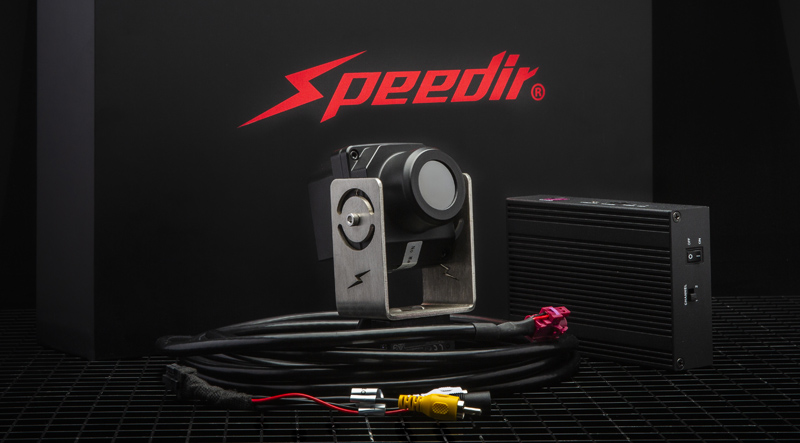 Invest in a Speedir thermal night vision camera. Above, we’ve
highlighted some great common-sense tips to help you avoid a potentially fatal
and likely avoidable incident! Following these steps will keep you safe for the
majority of the time. However, if you’d like some additional assurance
(particularly if you live in an area with a large deer population!), consider
investing in a Speedir thermal night vision camera.
Invest in a Speedir thermal night vision camera. Above, we’ve
highlighted some great common-sense tips to help you avoid a potentially fatal
and likely avoidable incident! Following these steps will keep you safe for the
majority of the time. However, if you’d like some additional assurance
(particularly if you live in an area with a large deer population!), consider
investing in a Speedir thermal night vision camera.
If you frequently travel in areas where deer are common, or you've had a close call or accident before, consider purchasing a thermal night vision camera for your vehicle. Unlike car AI that feeds information to a your car's computer, specialty cameras like the Night Owl Plus Infrared Deer Detector show you a real-time display of the objects and living things around you, with indicators to suggest distance and danger level. This helps you see a deer or any object before it becomes a problem, giving you both the time to react and the calm to make the right decision -- remember, brake sharply and don't swerve.
A thermal imaging system is, simply put, a heat sensor on your vehicle which transmits the same information to you as a camera would—before a light-based camera would be able to detect it. If you’re driving along a windy road at night, you won’t be able to see much; however, a thermal camera will reliably always be able to sense warm, living organisms on the road and around it.
Speedir Night owl Plus models come with artificial intelligence that can scan the heat-based images and tell you precisely when you’re coming close to a hazard, allowing you to have those precious seconds that will determine whether you can make a smart decision or allow your instincts to take over. As we’ve mentioned above, those seconds can be crucial in saving your car, the deer’s life, and that of your own.
Ultimately, the choice is yours. When you’re driving through deer country, you just want to be safe. Follow the above tips for safety, and if you’re going to be in this situation often—a thermal camera may just end up saving your life.
Oh, no! I hit a deer!
Even if you do everything right, sometimes it's not possible to avoid a deer collision. Indeed, how to avoid hitting a deer can often be a matter of luck than preparation or skill, though these are important factors in minimizing damage or injury. If you've had a collision, the first thing you should do is get all the occupants and the vehicle off the road. On a dark road, a stopped car may not be noticed by other vehicles, particularly if a serious accident has damaged your electrical components and knocked out your lights. After moving your vehicle off the road, set up hazard cones, flags or lights if you have them and then call the police. With a bad accident, their lights will help you stay safe as rescue efforts and cleanup occurs, and the increased commotion will warn other motorists of the danger that lies ahead.
Leave It Alone! If an unfortunate accident has occurred despite your best intentions and you have hit a deer, there are certain things you should and shouldn’t do. Don’t just drive away—there may be more damaged with your vehicle than you are aware. Also, don’t touch the animal! Even if it appears to be dead, it may just be wounded and frightened—exactly in the right mindset to attack if any stranger comes near. Stay in your vehicle and call the police—they’re trained to help in exactly this situation.
Call Your Insurance Agency. After you and the deer are no longer in harm’s way, take your car to a shop to assess what, exactly, has happened to your vehicle. If anything more than cosmetic scarring has happened to your vehicle, call your insurance agent immediately to report the damage and to see what policy coverage you have for natural accidents such as the one you have experienced.
From Your Friends at Speedir
Here at Speedir, we're passionate about keeping you and your loved ones safe and sound as you travel on our nation's roads and highways. A pioneering leader in advanced thermal and night vision technology, our products help drivers stay safe in low visibility situations such as nighttime or inclement weather. Call or click today to see how we can help you stay safe with advanced technology for any car, truck or commercial vehicle.

